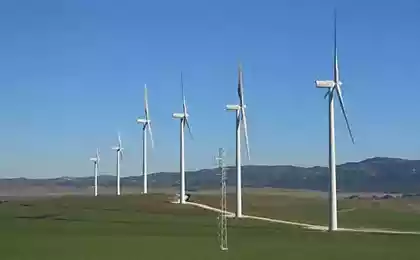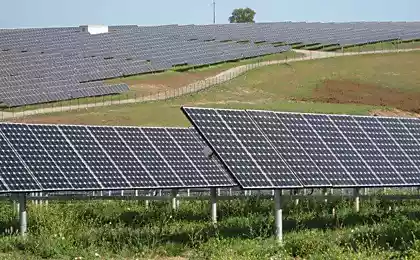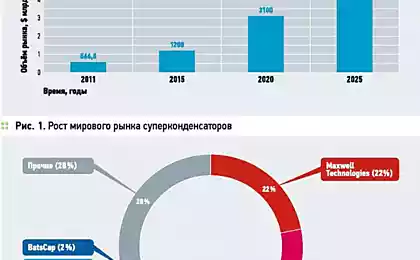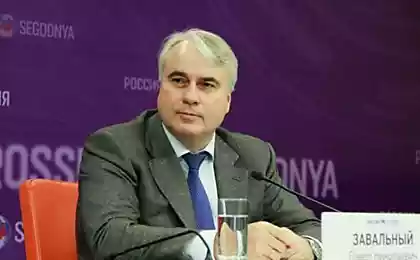987
Renewable energy sources and adverse environmental effects
This article is a continuation of the theme of energy development based on renewable energy sources (RES). We are talking about the contribution of energy from renewable sources in the emission of greenhouse gases and, in General, adverse environmental effects of energy development based on renewable energy. In some cases, the negative effects of renewable energy for environment and society can be great — contrary to the stated objectives on improving environmental performance, and each project requires a separate careful analysis. Overall, the positive and negative environmental effects of renewable question still require further comprehensive research.

Climatic aspects of renewable energy development is associated with "zero CO2 emissions" in solar, wind, hydraulic, and other power plants based on renewable resources. Indeed, in these cases, the development of energy without burning hydrocarbons and, as a consequence, without isolation of greenhouse gases and other pollutants into the atmosphere.
However, the situation is more complicated if we consider the entire life cycle of production, beginning with the preparatory stages and including side effects in the process of energy production.
For energy required manufacture and installation of power equipment, creation of infrastructure and provision of conditions for the preparation of raw materials, disposal of waste material and equipment at the end of its life. This requires metallurgical, machine-building, agricultural and other enterprises, the use of energy from fossil sources, and implies a non-zero emission.
Consideration of environmental impacts at all stages shows that the transition to renewable energy does not always lead to lower pollution, including lower emissions of CO2 and other greenhouse gases.
Study of side effects (including environmental) of renewable energy in the complex have a relatively recent history, and recently started talking about it more. One of the recent notable works — the work of the Norwegian researcher, researcher and project Manager in Western Norwegian research Institute (Western Norway Research Institute, WNRI), Otto Andersen (Otto Andersen) "Unintended consequences of renewable energy. Problems that require solutions." The work of Andersen uses previously gathered by different researchers information on the individual types of energy and regions on the basis of which builds up a generalized picture of environmental risks of renewable energy.
Key concepts and approaches associated with the life cycle analysis (Life Cycle Analysis, LCA) and evaluation of the so-called "counter effects", "effects of rebound" or "reverse effect" rebound effects that in Russian literature, translated as "restorative effects" or, without translation, "rebound-effects".
The focus from the standpoint of life cycle analysis and reciprocal effects is given to bioenergy (cultivation of energy crops for biofuel production), photovoltaic solar energy, some aspects of hydrogen energy and use of electric vehicles.
A number of questions remain open, research side effects of renewable energy has not been well studied topic, although in previous years on this subject was carried out a number of local research and experiments.
Renewable energy and greenhouse gas emissions
If we talk about GHG emissions, different types of renewable energy, according to Andersen, are not "rawnsley" (equally green) when viewed from the standpoint of the entire life cycle. The main indicator, from the point of view of greenhouse gas emissions associated with the production of energy used including Anderson, is the number of grams of CO2 equivalent per unit of produced energy, particularly for electricity taken 1 kWh, that is гСО2экв/kWh.
In this case, the important calculation methods and assumptions — first of all, for what time interval is calculated, and capacity utilization (the utilization rate of the installed capacity, i.e., capacity factor) and, therefore, the expected energy production over a certain period of time. The picture here is the same as with the calculation of justified costs (Levelized Costs, LC) per unit of energy. Often used 20-year interval.
Life cycle analysis gives the following emissions for different types of electricity production [гСО2экв/kWh]: wind — 12; intertidal — 15; hydraulic — 20; ocean wave 22; geothermal — 35; solar (photovoltaic) batteries — 40; solar concentrators — 10; bioenergy — 230.
This, however, in any case, on the order of less than the values given for energy, fossil raw materials: coal — 820; gas — 490. At the same time, the most "environmentally friendly", in this sense, is nuclear energy, where the rate of emission гСО2экв/kWh is only 12, that is, this parameter is set to the low level of energy from renewable sources. It is obvious that the distribution of greenhouse gases stages of the production life cycle for different types of energy differ dramatically (Fig. 1, tab. 1).
In the case of wind, solar, geothermal and hydropower, the main environmental load is on the production stage of materials, equipment and construction of stations. Similar structure and nuclear energy. Have energy using fossil fuels, the main part of emissions falls on the period of station operation, which requires the burning of fuel. The same is true for bioenergy. Thus, we can draw an analogy with the structure of costs in the first case, the "environmental costs" are rather fixed, in the second category of variables. In the first case, the advantages appear stronger at longer time intervals. In the second case to cut "carbon emission capacity of production" is possible through technologies that reduce fuel consumption and sequestration of greenhouse gases. In this case, in comparison with the "emission capacity" of wind and coal power is allowed a time interval of 20 years and capacity factor of wind farms is 30-40 %.
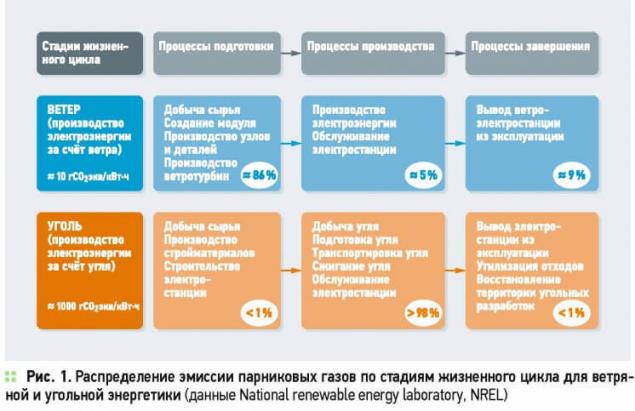
The focus from the standpoint of life cycle analysis and reciprocal effects is given to bioenergy (the cultivation of energy crops for biofuel production), photovoltaic solar energy, some aspects of hydrogen energy and use of electric vehicles
Note that the above is a rough average (median) values, there can be no great precision. A lot depends on the technology and specific production conditions. Data from different studies and different sources can dramatically diverge. In particular, for wind power variation can range from 2 to 80 гСО2экв/kWh (onlinelibrary.wiley.com).
For HPP index гСО2экв/kWh can reach 180. And "lower" values for power plants on fossil fuel — гСО2экв 200-300/kWh.
The reasons for the emission of greenhouse gases can reach high values for the life cycles of hydro, solar, bioenergy and geothermal power plants. In the case of HPP is, above all, the formation of a reservoir at the dam, which may form a stagnant mode with micro-biological decomposition of organic material in the dam area, causing rising emissions of CO2 and CH4 (methane). Similar processes are possible in the zones of tidal power plants. In the solar photovoltaic energy sector the main problems associated with the production process of solar panels, because among other risks for environment and health, it leads to the emission of some compounds of fluorine — hexafluorethane C2F6, nitrogen TRIFLUORIDE NF3, sulfur hexafluoride SF6, are powerful greenhouse gases. In the case of geothermal energy depends on the composition of the energy source — thermal waters, characterized by high temperature and salinity with complex chemical composition. In the course of its use and utilization is possible as a direct thermal pollution of the environment and the provision of the soil, water and atmosphere of several chemical compounds, including greenhouse gases.
Greenhouse gas emissions in the use of bioenergy occurs at all stages. First of all, it is in the cultivation phase of energy crops, in particular oilseed rape and oil palm. Intensive cultivation of rapeseed requires large amounts of nitrogen fertilizers leads to an increase in the emission of the powerful greenhouse gas nitrogen dioxide N20, which is, moreover, a destroyer of the ozone layer.
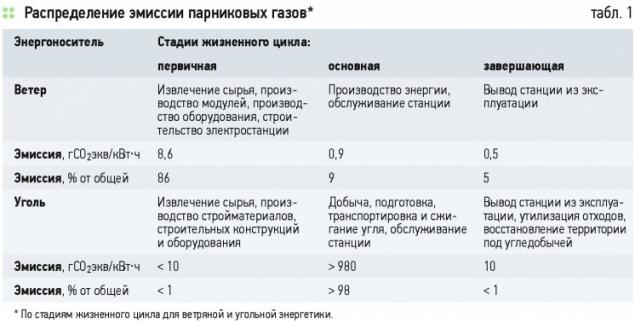
On average, as can be seen, despite rebound effect, greenhouse gas emissions in the life cycle of renewable energy sources remains significantly lower compared to non-renewable energy resources (excluding nuclear energy)
Large plantations of oil palm was established in South-East Asia (Indonesia, Malaysia, Thailand) on peat-bog lands, which are natural "traps" and "storage" of carbon, and tropical and Equatorial rain forest which acts as a "lungs of the planet". This caused the rapid destruction of the soil cover, disturbance of the natural regime of carbon uptake and, consequently, increase income of greenhouse gases (CO2 and CH4) into the atmosphere. In worst-case scenarios large-scale transition from fossil to biofuels may not reduce and even increase greenhouse gas emissions by up to 15 %.
Another, yet virtually unexplored aspect — the possible reduction in the overall albedo (reflectivity) of Land for large-scale dissemination of energy crops that could theoretically be a factor of climate warming.
At the operation stage — combustion (transport and power stations), usually produced in a mixture with fossil fuel, are also produced, as it turns out, the new chemical compounds, bearing as toxic and greenhouse risk. The increase in the emission of greenhouse gases as a consequence of the actions of its reduction is one of the examples rebound effect.
On average, as can be seen, despite this effect, the emission of greenhouse gases in the life cycle of renewable energy sources remains significantly lower compared to non-renewable energy resources (excluding nuclear energy).
At the same time, it is not in all cases and each specific project or program of development of power on renewable sources requires careful analysis including environmental position is always "greener" in comparison with other options they considered impossible.

Other side effects
In addition to greenhouse gas emissions as a counter effect, energy, renewable energy has other adverse environmental impacts. Hydroelectric and tidal power plants change the flow regime and temperatures of rivers and bays, become barriers to fish migration and other flows of matter and energy. In addition, one of the major side effects of hydro — flooding of areas suitable for settlement, agricultural and other activities.
Thus on the banks of the reservoirs at the hydroelectric power station can develop landslide processes, possible changes in local climatic conditions and the development of seismic phenomena. Stagnant water regime in the reservoirs are able to induce not only the growth of greenhouse gas emissions, but also the accumulation of harmful substances that pose a threat including to human health.
A separate danger in the breakthroughs and the collapse of hydroelectric dams, especially in mountainous and earthquake-prone areas. One of the largest catastrophes of this kind occurred in 1963, the year on the river vaiont (Vajont) in the Italian Alps, where in the reservoir at the hydroelectric dam went down a giant landslide that caused the overtopping of waves over the dam and the formation of tsunami up to a height of 90 m. a Huge wave was demolished several villages, killing more than 2,000 people.
Geothermal energy bears the risk of chemical contamination of water and soil — thermal fluids, in addition to carbon dioxide, contain sulfur sulfide H2S, ammonia NH3, methane CH4, table salt NaCl, boron B, and arsenic As, mercury Hg. There is a problem of disposal of hazardous waste. In addition, the possible corrosion destruction of constructions themselves to the thermal stations, and the pumping of thermal water may cause deformation of rock layers and local seismic events similar to those that occur in any mining operation or fence interstratal groundwater.
Bioenergetics is concerned with disposal of agricultural land (and other resources) for growing energy crops, for large-scale transition to the use of bioenergy can exacerbate the food problem in the world.
With a rough calculation shows that the cultivation of rapeseed or sunflower as raw material for biofuels can yield about one ton of biofuel from 1 ha of cultivated land. Total world energy consumption reaches 20 billion tonnes of oil equivalent. The substitution of this amount of biofuel to 10 %, or 2 billion tons, would have required exclusion of about 2 billion hectares, or about 40% of all agricultural land in the world or 15 % of the world's land area excluding Antarctica. A major expansion of energy monocultures reduces biodiversity, both directly and indirectly through the deterioration of habitat for many species of flora and fauna.
At the stage of burning of biological fuels, particularly in transportation, by blending with fossil fuels (conventional diesel or gasoline) and the use of additives to work better in winter conditions, is the formation of new chemical compounds, toxic and carcinogenic properties. It showed, in particular, observations and experiments in the study, "the Impact biocomponent of fuel composition on emissions of diesel engines and diesel oil deterioration" (Influence of biocomponents content in fuel on emissions from diesel engines and engine oil deterioration).
In this regard, a relatively preferred looks of algal energy — getting energy raw materials from algae. Among the known cultures such as Botryococcus bran-nil and Arthrospira (Spirulina) platensis. Algae, compared to "land" with the energy crops have higher (in certain conditions — much higher) productivity per unit area per unit time and a higher content of fats (lipids) — feedstock for biofuel production. In addition, cultivation of algae is not associated with the alienation of productive agricultural land, the creation of complex structures and equipment, using large amount of fertilizers. While algae is one of the most powerful absorbers of carbon dioxide and producers of oxygen. In this regard, it is the direction of renewable energy, while under-developed, can be considered very promising and with a production and environmental standpoint.
Wind energy is the least dangerous from the point of view of greenhouse gas emissions and pollutants, causes at the same time, a number of claims of environmentalists in other positions. They include noise pollution of the area, the "aesthetic pollution", the risk of exposing the rotating blades on the psyche. Another group of claims is associated with exposure to fauna — in particular, the turbines can scare birds and cause their deaths in a collision with the blades.

The problem is also increasing over time, especially as the construction of offshore (offshore) wind farms — access problems for service and emergency services, difficulties in maintenance, repair of damages and emergency situations, particularly during fire wind
Accumulated operating experience of wind turbines numbering in Western Europe for about 20 years, shows that these claims are more speculative in any case, when the density of wind turbines and compliance with certain security measures, in particular the placement of turbines no less than a few hundred meters from residential areas. More real look other problems. One of them is obvious — wind farms require large areas, and there are certain limits to their installation in areas with high population density and infrastructure. Another problem, becoming with time more pressing — recycling end-of-life wind turbine blades constructed from composite materials and carrying a high potential of environmental pollution.
The following issue is also growing over time, especially as the construction of offshore (offshore) wind farms — access problems for service and emergency services, difficulties in maintenance, repair of damages and emergency situations, in particular, in case of fire in wind turbines.
All the above problems can worsen, creating a multiplier effect in the wider dissemination of wind energy. Currently it accounts for about 9% of total electricity production in Germany, about 5% in Italy, 18 % in Spain. In other major countries-producers of electricity is a considerably smaller share, on average, in the world she is about 2.5 %. What effects may cause increase in wind power capacity in two to three times and more is a separate issue for study.
In solar energy the main environmental risks associated with the use of a large number of toxic and explosive components in the manufacture of solar panels. In particular, solar panels contain cadmium telluride CdTe, cadmium sulfide CdS, gallium arsenide GaAs, and the production process uses fluorine, which creates a number of toxic compounds. This creates a problem, first at the manufacturing stage, and then at the stage of battery disposal, exhaust their resources. This problem will inevitably grow over time. Another problem of solar cell production — large amounts of water consumption. According to American data, the consumption of water of high purity for the production of 1 MW of capacity — about 10 l/min.
The integral indicator used for evaluation of the damage of a particular type of activity for society and environment is the external, or external costs (external costs) are not included in the price of the product costs incurred by society as a whole, that is caused by socio-economic and socio-natural damage. External costs include damage to human health, corrosion, and other damage caused to materials and structures, reducing yields, etc.
In the assessment of external costs depends on many assumptions, they can dramatically differ across countries. In particular, for EU countries the range of external costs of electricity production (cents per kWh) for different energy sources are (according ec.europa.eu): coal is 2-15; oil — 3-11; gas — 1-4; nuclear energy — 0,2-0,7; biomass 0-5; hydro — 0-1; solar (photovoltaic) energy — 0.6; wind — 0-0,25.
Germany (the largest electricity producer in Europe with a wide development of energy from renewable energy sources) external marginal (variable) production costs of electricity from various sources are estimated at the following values (cents per kWh): coal — 0,75; gas — 0,35; nuclear energy — 0,17; solar — 0,46; wind — 0,08; hydro — 0,05.
Here we also see that energy carries to renewable energy sources, on average, noticeably lower cost to society than the generation of energy from fossil raw materials.
At the same time, nuclear energy finds high environmental competitiveness, despite the fact that with the known nuclear power plant accidents in Chernobyl and Fukushima, its reputation in the eyes of society significantly undermined.

The development of energy from RES requires additional use of non-renewable resources: raw materials for fertilizers in the case of bioenergy, metal for equipment and building structures, fossil natural gas to produce hydrogen fuel from fossil energy sources to operate these industries
Additional complexity and issues related to what stages of the life cycle can be distributed in different countries. In particular, the initial stage, which account for the bulk of external costs, such as cultivation of energy crops or the production of solar cells, often held outside Europe and North America. So, at this point almost 60% of all solar panels in the world are produced in China.
Operational phase, which in the case of renewable energy accounts for a minimum share of the costs associated with the Western countries — consumers of "green" energy, but the costs of the final stage of recycling, can also be imposed in other regions.
In other words, in the case of energy based on renewable energy sources is also possible that the principal benefit some groups and the costs borne by others. The distribution of benefits and costs is also an important issue with a social dimension.
However, the fundamental problem is that development of energy from RES requires additional use of non-renewable resources: raw materials for fertilizers in the case of bioenergy, metal for equipment and building structures, fossil natural gas to produce hydrogen fuel from fossil energy sources to operate these industries. Accordingly, increasing the energy production by renewable energy sources will require and increased consumption of non-renewable resources. The situation in which we can talk about unqualified success and viability of renewable energy — creation of complete production cycles, where the production of renewable energy is provided from renewable sources. published
Source: www.c-o-k.ru/articles/vie-i-pobochnye-ekologicheskie-effekty

Climatic aspects of renewable energy development is associated with "zero CO2 emissions" in solar, wind, hydraulic, and other power plants based on renewable resources. Indeed, in these cases, the development of energy without burning hydrocarbons and, as a consequence, without isolation of greenhouse gases and other pollutants into the atmosphere.
However, the situation is more complicated if we consider the entire life cycle of production, beginning with the preparatory stages and including side effects in the process of energy production.
For energy required manufacture and installation of power equipment, creation of infrastructure and provision of conditions for the preparation of raw materials, disposal of waste material and equipment at the end of its life. This requires metallurgical, machine-building, agricultural and other enterprises, the use of energy from fossil sources, and implies a non-zero emission.
Consideration of environmental impacts at all stages shows that the transition to renewable energy does not always lead to lower pollution, including lower emissions of CO2 and other greenhouse gases.
Study of side effects (including environmental) of renewable energy in the complex have a relatively recent history, and recently started talking about it more. One of the recent notable works — the work of the Norwegian researcher, researcher and project Manager in Western Norwegian research Institute (Western Norway Research Institute, WNRI), Otto Andersen (Otto Andersen) "Unintended consequences of renewable energy. Problems that require solutions." The work of Andersen uses previously gathered by different researchers information on the individual types of energy and regions on the basis of which builds up a generalized picture of environmental risks of renewable energy.
Key concepts and approaches associated with the life cycle analysis (Life Cycle Analysis, LCA) and evaluation of the so-called "counter effects", "effects of rebound" or "reverse effect" rebound effects that in Russian literature, translated as "restorative effects" or, without translation, "rebound-effects".
The focus from the standpoint of life cycle analysis and reciprocal effects is given to bioenergy (cultivation of energy crops for biofuel production), photovoltaic solar energy, some aspects of hydrogen energy and use of electric vehicles.
A number of questions remain open, research side effects of renewable energy has not been well studied topic, although in previous years on this subject was carried out a number of local research and experiments.
Renewable energy and greenhouse gas emissions
If we talk about GHG emissions, different types of renewable energy, according to Andersen, are not "rawnsley" (equally green) when viewed from the standpoint of the entire life cycle. The main indicator, from the point of view of greenhouse gas emissions associated with the production of energy used including Anderson, is the number of grams of CO2 equivalent per unit of produced energy, particularly for electricity taken 1 kWh, that is гСО2экв/kWh.
In this case, the important calculation methods and assumptions — first of all, for what time interval is calculated, and capacity utilization (the utilization rate of the installed capacity, i.e., capacity factor) and, therefore, the expected energy production over a certain period of time. The picture here is the same as with the calculation of justified costs (Levelized Costs, LC) per unit of energy. Often used 20-year interval.
Life cycle analysis gives the following emissions for different types of electricity production [гСО2экв/kWh]: wind — 12; intertidal — 15; hydraulic — 20; ocean wave 22; geothermal — 35; solar (photovoltaic) batteries — 40; solar concentrators — 10; bioenergy — 230.
This, however, in any case, on the order of less than the values given for energy, fossil raw materials: coal — 820; gas — 490. At the same time, the most "environmentally friendly", in this sense, is nuclear energy, where the rate of emission гСО2экв/kWh is only 12, that is, this parameter is set to the low level of energy from renewable sources. It is obvious that the distribution of greenhouse gases stages of the production life cycle for different types of energy differ dramatically (Fig. 1, tab. 1).
In the case of wind, solar, geothermal and hydropower, the main environmental load is on the production stage of materials, equipment and construction of stations. Similar structure and nuclear energy. Have energy using fossil fuels, the main part of emissions falls on the period of station operation, which requires the burning of fuel. The same is true for bioenergy. Thus, we can draw an analogy with the structure of costs in the first case, the "environmental costs" are rather fixed, in the second category of variables. In the first case, the advantages appear stronger at longer time intervals. In the second case to cut "carbon emission capacity of production" is possible through technologies that reduce fuel consumption and sequestration of greenhouse gases. In this case, in comparison with the "emission capacity" of wind and coal power is allowed a time interval of 20 years and capacity factor of wind farms is 30-40 %.

The focus from the standpoint of life cycle analysis and reciprocal effects is given to bioenergy (the cultivation of energy crops for biofuel production), photovoltaic solar energy, some aspects of hydrogen energy and use of electric vehicles
Note that the above is a rough average (median) values, there can be no great precision. A lot depends on the technology and specific production conditions. Data from different studies and different sources can dramatically diverge. In particular, for wind power variation can range from 2 to 80 гСО2экв/kWh (onlinelibrary.wiley.com).
For HPP index гСО2экв/kWh can reach 180. And "lower" values for power plants on fossil fuel — гСО2экв 200-300/kWh.
The reasons for the emission of greenhouse gases can reach high values for the life cycles of hydro, solar, bioenergy and geothermal power plants. In the case of HPP is, above all, the formation of a reservoir at the dam, which may form a stagnant mode with micro-biological decomposition of organic material in the dam area, causing rising emissions of CO2 and CH4 (methane). Similar processes are possible in the zones of tidal power plants. In the solar photovoltaic energy sector the main problems associated with the production process of solar panels, because among other risks for environment and health, it leads to the emission of some compounds of fluorine — hexafluorethane C2F6, nitrogen TRIFLUORIDE NF3, sulfur hexafluoride SF6, are powerful greenhouse gases. In the case of geothermal energy depends on the composition of the energy source — thermal waters, characterized by high temperature and salinity with complex chemical composition. In the course of its use and utilization is possible as a direct thermal pollution of the environment and the provision of the soil, water and atmosphere of several chemical compounds, including greenhouse gases.
Greenhouse gas emissions in the use of bioenergy occurs at all stages. First of all, it is in the cultivation phase of energy crops, in particular oilseed rape and oil palm. Intensive cultivation of rapeseed requires large amounts of nitrogen fertilizers leads to an increase in the emission of the powerful greenhouse gas nitrogen dioxide N20, which is, moreover, a destroyer of the ozone layer.

On average, as can be seen, despite rebound effect, greenhouse gas emissions in the life cycle of renewable energy sources remains significantly lower compared to non-renewable energy resources (excluding nuclear energy)
Large plantations of oil palm was established in South-East Asia (Indonesia, Malaysia, Thailand) on peat-bog lands, which are natural "traps" and "storage" of carbon, and tropical and Equatorial rain forest which acts as a "lungs of the planet". This caused the rapid destruction of the soil cover, disturbance of the natural regime of carbon uptake and, consequently, increase income of greenhouse gases (CO2 and CH4) into the atmosphere. In worst-case scenarios large-scale transition from fossil to biofuels may not reduce and even increase greenhouse gas emissions by up to 15 %.
Another, yet virtually unexplored aspect — the possible reduction in the overall albedo (reflectivity) of Land for large-scale dissemination of energy crops that could theoretically be a factor of climate warming.
At the operation stage — combustion (transport and power stations), usually produced in a mixture with fossil fuel, are also produced, as it turns out, the new chemical compounds, bearing as toxic and greenhouse risk. The increase in the emission of greenhouse gases as a consequence of the actions of its reduction is one of the examples rebound effect.
On average, as can be seen, despite this effect, the emission of greenhouse gases in the life cycle of renewable energy sources remains significantly lower compared to non-renewable energy resources (excluding nuclear energy).
At the same time, it is not in all cases and each specific project or program of development of power on renewable sources requires careful analysis including environmental position is always "greener" in comparison with other options they considered impossible.

Other side effects
In addition to greenhouse gas emissions as a counter effect, energy, renewable energy has other adverse environmental impacts. Hydroelectric and tidal power plants change the flow regime and temperatures of rivers and bays, become barriers to fish migration and other flows of matter and energy. In addition, one of the major side effects of hydro — flooding of areas suitable for settlement, agricultural and other activities.
Thus on the banks of the reservoirs at the hydroelectric power station can develop landslide processes, possible changes in local climatic conditions and the development of seismic phenomena. Stagnant water regime in the reservoirs are able to induce not only the growth of greenhouse gas emissions, but also the accumulation of harmful substances that pose a threat including to human health.
A separate danger in the breakthroughs and the collapse of hydroelectric dams, especially in mountainous and earthquake-prone areas. One of the largest catastrophes of this kind occurred in 1963, the year on the river vaiont (Vajont) in the Italian Alps, where in the reservoir at the hydroelectric dam went down a giant landslide that caused the overtopping of waves over the dam and the formation of tsunami up to a height of 90 m. a Huge wave was demolished several villages, killing more than 2,000 people.
Geothermal energy bears the risk of chemical contamination of water and soil — thermal fluids, in addition to carbon dioxide, contain sulfur sulfide H2S, ammonia NH3, methane CH4, table salt NaCl, boron B, and arsenic As, mercury Hg. There is a problem of disposal of hazardous waste. In addition, the possible corrosion destruction of constructions themselves to the thermal stations, and the pumping of thermal water may cause deformation of rock layers and local seismic events similar to those that occur in any mining operation or fence interstratal groundwater.
Bioenergetics is concerned with disposal of agricultural land (and other resources) for growing energy crops, for large-scale transition to the use of bioenergy can exacerbate the food problem in the world.
With a rough calculation shows that the cultivation of rapeseed or sunflower as raw material for biofuels can yield about one ton of biofuel from 1 ha of cultivated land. Total world energy consumption reaches 20 billion tonnes of oil equivalent. The substitution of this amount of biofuel to 10 %, or 2 billion tons, would have required exclusion of about 2 billion hectares, or about 40% of all agricultural land in the world or 15 % of the world's land area excluding Antarctica. A major expansion of energy monocultures reduces biodiversity, both directly and indirectly through the deterioration of habitat for many species of flora and fauna.
At the stage of burning of biological fuels, particularly in transportation, by blending with fossil fuels (conventional diesel or gasoline) and the use of additives to work better in winter conditions, is the formation of new chemical compounds, toxic and carcinogenic properties. It showed, in particular, observations and experiments in the study, "the Impact biocomponent of fuel composition on emissions of diesel engines and diesel oil deterioration" (Influence of biocomponents content in fuel on emissions from diesel engines and engine oil deterioration).
In this regard, a relatively preferred looks of algal energy — getting energy raw materials from algae. Among the known cultures such as Botryococcus bran-nil and Arthrospira (Spirulina) platensis. Algae, compared to "land" with the energy crops have higher (in certain conditions — much higher) productivity per unit area per unit time and a higher content of fats (lipids) — feedstock for biofuel production. In addition, cultivation of algae is not associated with the alienation of productive agricultural land, the creation of complex structures and equipment, using large amount of fertilizers. While algae is one of the most powerful absorbers of carbon dioxide and producers of oxygen. In this regard, it is the direction of renewable energy, while under-developed, can be considered very promising and with a production and environmental standpoint.
Wind energy is the least dangerous from the point of view of greenhouse gas emissions and pollutants, causes at the same time, a number of claims of environmentalists in other positions. They include noise pollution of the area, the "aesthetic pollution", the risk of exposing the rotating blades on the psyche. Another group of claims is associated with exposure to fauna — in particular, the turbines can scare birds and cause their deaths in a collision with the blades.

The problem is also increasing over time, especially as the construction of offshore (offshore) wind farms — access problems for service and emergency services, difficulties in maintenance, repair of damages and emergency situations, particularly during fire wind
Accumulated operating experience of wind turbines numbering in Western Europe for about 20 years, shows that these claims are more speculative in any case, when the density of wind turbines and compliance with certain security measures, in particular the placement of turbines no less than a few hundred meters from residential areas. More real look other problems. One of them is obvious — wind farms require large areas, and there are certain limits to their installation in areas with high population density and infrastructure. Another problem, becoming with time more pressing — recycling end-of-life wind turbine blades constructed from composite materials and carrying a high potential of environmental pollution.
The following issue is also growing over time, especially as the construction of offshore (offshore) wind farms — access problems for service and emergency services, difficulties in maintenance, repair of damages and emergency situations, in particular, in case of fire in wind turbines.
All the above problems can worsen, creating a multiplier effect in the wider dissemination of wind energy. Currently it accounts for about 9% of total electricity production in Germany, about 5% in Italy, 18 % in Spain. In other major countries-producers of electricity is a considerably smaller share, on average, in the world she is about 2.5 %. What effects may cause increase in wind power capacity in two to three times and more is a separate issue for study.
In solar energy the main environmental risks associated with the use of a large number of toxic and explosive components in the manufacture of solar panels. In particular, solar panels contain cadmium telluride CdTe, cadmium sulfide CdS, gallium arsenide GaAs, and the production process uses fluorine, which creates a number of toxic compounds. This creates a problem, first at the manufacturing stage, and then at the stage of battery disposal, exhaust their resources. This problem will inevitably grow over time. Another problem of solar cell production — large amounts of water consumption. According to American data, the consumption of water of high purity for the production of 1 MW of capacity — about 10 l/min.
The integral indicator used for evaluation of the damage of a particular type of activity for society and environment is the external, or external costs (external costs) are not included in the price of the product costs incurred by society as a whole, that is caused by socio-economic and socio-natural damage. External costs include damage to human health, corrosion, and other damage caused to materials and structures, reducing yields, etc.
In the assessment of external costs depends on many assumptions, they can dramatically differ across countries. In particular, for EU countries the range of external costs of electricity production (cents per kWh) for different energy sources are (according ec.europa.eu): coal is 2-15; oil — 3-11; gas — 1-4; nuclear energy — 0,2-0,7; biomass 0-5; hydro — 0-1; solar (photovoltaic) energy — 0.6; wind — 0-0,25.
Germany (the largest electricity producer in Europe with a wide development of energy from renewable energy sources) external marginal (variable) production costs of electricity from various sources are estimated at the following values (cents per kWh): coal — 0,75; gas — 0,35; nuclear energy — 0,17; solar — 0,46; wind — 0,08; hydro — 0,05.
Here we also see that energy carries to renewable energy sources, on average, noticeably lower cost to society than the generation of energy from fossil raw materials.
At the same time, nuclear energy finds high environmental competitiveness, despite the fact that with the known nuclear power plant accidents in Chernobyl and Fukushima, its reputation in the eyes of society significantly undermined.

The development of energy from RES requires additional use of non-renewable resources: raw materials for fertilizers in the case of bioenergy, metal for equipment and building structures, fossil natural gas to produce hydrogen fuel from fossil energy sources to operate these industries
Additional complexity and issues related to what stages of the life cycle can be distributed in different countries. In particular, the initial stage, which account for the bulk of external costs, such as cultivation of energy crops or the production of solar cells, often held outside Europe and North America. So, at this point almost 60% of all solar panels in the world are produced in China.
Operational phase, which in the case of renewable energy accounts for a minimum share of the costs associated with the Western countries — consumers of "green" energy, but the costs of the final stage of recycling, can also be imposed in other regions.
In other words, in the case of energy based on renewable energy sources is also possible that the principal benefit some groups and the costs borne by others. The distribution of benefits and costs is also an important issue with a social dimension.
However, the fundamental problem is that development of energy from RES requires additional use of non-renewable resources: raw materials for fertilizers in the case of bioenergy, metal for equipment and building structures, fossil natural gas to produce hydrogen fuel from fossil energy sources to operate these industries. Accordingly, increasing the energy production by renewable energy sources will require and increased consumption of non-renewable resources. The situation in which we can talk about unqualified success and viability of renewable energy — creation of complete production cycles, where the production of renewable energy is provided from renewable sources. published
Source: www.c-o-k.ru/articles/vie-i-pobochnye-ekologicheskie-effekty


